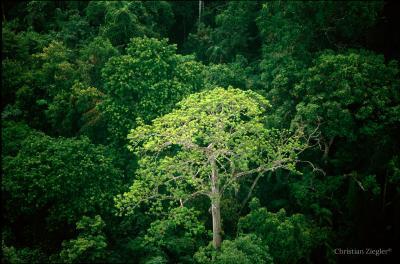A satellite image of a green swath of tropical forest does not tell the whole story. About half the world's tropical forests are relatively young. Unless protected, they are unlikely to last more than a human generation before falling to bulldozers and chainsaws. These ephemeral secondary forests may contribute little to tree-biodiversity conservation, according to a new report by scientists at the Smithsonian Tropical Research Institute in Panama.
"Secondary forests in the tropics are normally cut within a few decades and very often in less than 10 years," said Michiel van Breugel, post-doctoral fellow at STRI and lead author of the study published Dec. 11 in PLOS ONE. "From the perspective of conserving tree species, this doesn't work." Even 30-year-old forests have a very low percentage of the reproductive trees essential to long-term species survival.
Perhaps the most extensive of its kind in the tropics, van Breugel's study suggests that forests subjected to regular human disturbance may undergo profound, long-lasting tree biodiversity loss. Whereas fallow forests can have a surprisingly high tree-biodiversity, a large proportion of tree species only occur as seedlings and saplings. They do not reproduce before the forests are cleared again.
"A tree only contributes to the conservation of its species when it arrives at a site, establishes, grows and reproduces," said van Breugel.
The research was conducted on the Smithsonian's 700-hectare Panama Canal Watershed Experiment, a long-term research site designed to quantify ecosystem services provided by different land uses.
Van Breugel and colleagues had two questions in mind: First can secondary forests recover their original diversity through natural succession in the long-term? And to what extent can short-lived secondary forests in dynamic agricultural landscapes contribute to the conservation of a high diversity of tree species? They randomly selected 45 secondary forest plots ranging from two to 32 years of age in which they counted more than 52,000 trees, palms and lianas. To the authors' knowledge, this was the first metacommunity study of its kind ever conducted in the tropics.
In the study plots, researchers found 324 tree and shrub species, about 55 percent of Agua Salud's suite of approximately 600 tree species. They estimated relative reproductive size thresholds and determined that in forests between 18 and 34 years of age, 51 percent (137 of 268 species) reached reproductive size. In forests between two and seven years of age, the figure fell to 36 percent (79 of 220 species). Importantly, these included few large-canopy species, slow-growing shade-tolerant understory species and species that depend on forest-dependent animals for seed dispersal.
If left undisturbed, secondary forests may regain levels of tree diversity similar to those of mature forests—but only when the surrounding landscape includes natural seed sources like protected parkland, patches of old forest and remnant trees as it did in this case. The research underscores the importance of protecting old forests to maintain the tree diversity for which the tropics are famous.
"In the long term, we might see a distinct shift in the functional composition of human-altered landscapes," said van Breugel. "This kind of landscape becomes more and more dominated by a small group of species with specific traits like the ability to survive grazing and fire, high fecundity, good dispersal and the ability to grow to a reproductive age in a short period of time. On the other hand, many shade-tolerant trees are poorly dispersed, grow slowly and depend on forest-bound species for pollination and dispersal. Their conservation will depend on our ability to protect large areas of old-growth forests."

Young tropical forests lose biodiversity as they suffer repeated disturbance, a new Smithsonian study confirms.
(Photo Credit: Christian Ziegler, STRI)